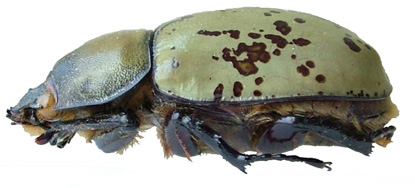 |
|||||||
|
|||||||
male, dorsal view
female, dorsal view
male, lateral view
female, lateral view
Photos by Mathew R. Moore
Distribution: Eastern and southeastern United States: Arkansas, Alabama, Delaware, Florida, Georgia, Illinois, Indiana, Kentucky, Louisiana, Maryland, Mississippi, Missouri, New Jersey, New York, North Carolina, Ohio, Oklahoma, Pennsylvania, South Carolina, Tennessee, Texas, and Virginia.
|
||
|
|
||
| Dynastinae Taxa Map | ||
| Dynastini key | ||
| Pentodontini key |
Description: Pronotal horn in males shorter than pronotum, horn weakly emarginated at apex (dorsal view). Clypeal horn with weak tubercles near apex (lateral view). Pronotum and elytra glabrous, dark-olive green in both sexes. Clypeus of female constricted laterally near apex and shallowly emarginated at apex.
Biological Data: Dynastes tityus is a common beetle in the hardwood forests of the eastern United States. Adults have been observed stripping bark from ash trees (Fraxinus spp., Oleaceae) and lapping up sap (Manee 1915). Larvae and adults can be found together at large breeding sites within various tree species. The most common host trees are mature oak (Quercus spp., Fagaceae), pine (Pinus spp., Pinaceae), cherry (Prunus spp., Rosaceae), black locust (Robinia spp., Fabaceae), and willow (Salix spp., Salicaceae) (Glaser 1976). The larvae feed exclusively on decaying wood and litter within hollowed out trees, converting it into characteristically flattened, rectangular fecal pellets about 10 mm long (Glaser 1976). Adults will continue to oviposit in the same tree until all nutrients are exhausted from that site. This leads to an overlapping of generations within a single tree (Glaser 1976). Oviposition of 1-91 eggs takes place in August. The larvae feed for approximately 660 days before the third instar larvae pupate. Pupal cells are built using woody debris and fecal pellets. Pupal cells are often built in close proximity to each other. Adults emerge in six to eight weeks. The entire life cycle of D. tityus can last for two to three years depending on the conditions in which the larvae develop (Glaser 1976). In his work on D. tityus in Maryland, Glaser (1976) found that the aggregate ratio of males to females was nearly 2:1.
Temporal Distribution: June and July. Adults are most often collected at lights at night or at their oviposition sites (Glaser 1976).
Larvae: Ritcher (1966) described the third instar larvae.
References:
Endrödi, S. 1985. The Dynastinae of the World. Series Entomologica. Volume 28, W. Junk, Dordrecht. 800 pp., 46 plates.
Glaser, J. 1976. The Biology of Dynastes tityus (Linn.) in Maryland (Coleoptera: Scarabaeidae). Coleopterists Bulletin 30(2): 133-138.
Manee, A.H. 1915. Observations in Southern Pines, North Carolina (Hym., Col.). Entomological News 26: 265-268.
Ritcher, P.O. 1966. White Grubs and Their Allies. Oregon State University Press, Corvallis, OR. 219 pp.
|
||||
|
|



